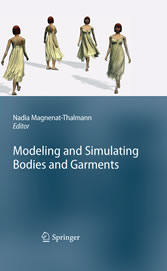Search and Find
Service
Preface
6
Contents
8
List of Figures
12
Chapter 1: Modeling Bodies
20
1.1 Introduction
20
1.2 Geometric Modeling
21
1.2.1 Basic Geometric Deformations
22
1.2.2 Free Form Deformation
23
1.3 Physically Based Modeling
31
1.4 Anatomic and Anthropometric Body Modeling Techniques
33
1.5 Data Acquisition
43
1.5.1 Data Acquisition and Reconstruction Pipeline
44
1.5.2 Data Resolution and Data Format
46
1.5.3 Scan Data Based Modeling Approaches
47
References
48
Chapter 2: Character Based Adaptation
50
2.1 Introduction
50
2.1.1 Character Animation
50
2.2 Previous Works
52
2.3 A Footskate Removal Method for Simplified Characters
54
2.3.1 Feet Motion Analysis
55
2.3.1.1 Foot Selection
55
2.3.1.2 Vertex Selection
56
2.4 Root Translation Correction
57
2.4.1 Horizontal Correction
57
2.4.2 Vertical Correction
59
2.5 Character Movements Adaptation
61
2.5.1 Introduction
61
2.5.2 Skeleton Design
63
2.5.2.1 Limbs Simplification
64
2.5.2.2 Vertex/Cylinder Allocation
66
2.5.2.3 Penetration Calculation
67
2.5.3 Arms Adaptation
68
2.5.3.1 Penetration Removal
68
Objective Function
69
2.5.3.2 Forearm Orientation Correction
70
2.5.4 Legs Adaptation
72
2.5.5 General Purpose Collisions Removal
74
2.5.6 Balance Correction
74
2.5.6.1 Character Setup
75
Weights Estimation
75
Threshold Distances Calculation
76
2.5.6.2 Balance Optimization
77
2.5.6.3 Runtime System
79
Radial Basis Functions
81
Data Pre-processing
83
Skeleton Adaptation
84
A Growing Body
85
Joints Translation
87
References
87
Chapter 3: Cloth Modeling and Simulation
90
3.1 A Brief History on Garment Simulation
90
3.2 Measuring Physical Parameters
94
3.2.1 Introduction
94
3.2.2 The Concept of Fabric Hand
94
3.2.2.1 Subjective Fabric Hand Assessment
96
3.2.2.2 Objective Hand Measurements
97
Fundamental Research
97
Kawabata (KES-f) (Kawabata 1980)
102
Other Measurement Systems
108
3.2.3 Fabric Drape
108
3.2.4 Mechanical and Physical Fabric Properties in Virtual Simulation Systems
110
3.3 Physical Simulation of Cloth
111
3.3.1 Introduction
111
3.3.2 Physical Properties of Cloth Materials
112
3.3.3 Simulation Models
114
3.3.3.1 Generalities on Mechanical Simulation
114
3.3.3.2 State-of-the-Art in Cloth Simulation Techniques
115
3.3.4 A Simple Method for Accurate Simulation of Nonlinear Cloth Materials
118
3.3.5 Numerical Integration
122
3.3.5.1 Explicit Integration Methods
122
3.3.5.2 Implicit Integration Methods
124
3.3.6 Collision Processing
125
3.3.6.1 Techniques for Collision Detection on Cloth Objects
127
3.3.6.2 Collision Response
129
3.3.6.3 Repairing Collisions
130
3.3.7 Real-Time Garment Animation
131
3.3.7.1 Real-Time Garment Animation on a Virtual Character
132
3.4 Touching Virtual Textiles
134
3.4.1 Haptic Interaction with Virtual Textiles: The Problems to Solve
135
3.4.1.1 Abstraction of the Real World Scenario
136
3.4.1.2 Development of Physically Based Simulation Techniques to Render the Cloth Behavior According to the Specified Fabric
136
3.4.1.3 Design and Realization of a Haptic Interface Able to Provide Both Tactile and Kinesthetic Stimuli
137
3.4.1.4 Cross-Modal Validation of the Complete System
137
3.4.2 The Sense of Touch
137
3.4.2.1 The Tactile Sense
138
3.4.2.2 The Kinesthetic Sense
138
3.4.3 Rendering Touch Signals
139
3.4.3.1 The Haptic Interaction Process
139
3.4.3.2 Tactile Rendering
140
3.4.3.3 Force Rendering
141
3.4.4 Haptic Interfaces
142
3.4.4.1 Commercial Devices
143
3.4.4.2 Tactile Actuators
143
3.4.4.3 Multipoint Force-Feedback Devices
145
3.4.4.4 Integration and Synchronization
145
3.4.5 The EU Project HAPTEX: Concepts and Solutions
147
3.4.5.1 Validation
147
3.4.5.2 Results
149
Textile Simulation
149
Fabric Measurements
149
Force-Feedback and Tactile Rendering
150
Whole Haptic Interface
150
Milestones
151
References
151
Chapter 4: Designing and Animating Patterns and Clothes
158
4.1 Introduction
158
4.2 Pattern Design
159
4.2.1 Digitalization
159
4.2.2 Import from CAD Software
159
4.2.3 Extraction of the Outer Shell Pattern Pieces
160
4.3 Pattern Placement
161
4.4 Seaming
162
4.5 Fabric Properties
162
4.6 Garment Fitting
163
4.7 Comparison of Real and Virtual Fitting Processes
164
4.7.1 Physical Precision of the Simulation Result
166
4.8 The Making of the Award Winning Film: High Fashion in Equations
168
4.8.1 Introduction
168
4.8.2 Robert Piguet
169
4.8.3 Inspiration
170
4.8.4 Design and Implementation
171
4.8.4.1 Unlimited Parameters for Virtual Representations
171
4.8.4.2 Design of 2D Patterns
173
4.8.4.3 Fabric Material
173
4.8.4.4 Intended Aesthetic
175
4.8.4.5 Animation
176
4.8.4.6 Final Composition
176
4.8.5 Result
177
References
178
Chapter 5: Virtual Prototyping and Collaboration in the Clothing Industry
180
5.1 Introduction
180
5.2 The New Market Trend
182
5.3 Virtual Prototyping of Garments
182
5.3.1 Current Design and Manufacturing Paradigms
183
5.3.2 Current Online Garment Customization
185
5.3.3 MIRALab’s Virtual Try On
186
5.4 Collaboration in Virtual Clothing
190
5.4.1 Distinction Between PDM and PLM
190
5.4.2 PDM/PLM in the Apparel Industry: Current Solutions/Examples and Their Benefits
192
5.5 Future Challenge: Co-design
192
5.6 Towards a Co-design Virtual Garments Platform
193
5.6.1 Related Work
194
5.6.2 Design Considerations
196
5.6.3 Communication Architecture
196
5.6.4 User Membership Management
198
5.6.5 Content Transmission Scheme
199
5.6.6 Event Management
200
5.6.7 Proposed Architecture
200
5.6.8 Overall Architecture
201
5.6.8.1 Application Stub
202
5.6.8.2 Node Manager
203
5.6.8.3 Event Manager
203
5.6.8.4 Communication Manager
204
References
204
All prices incl. VAT













